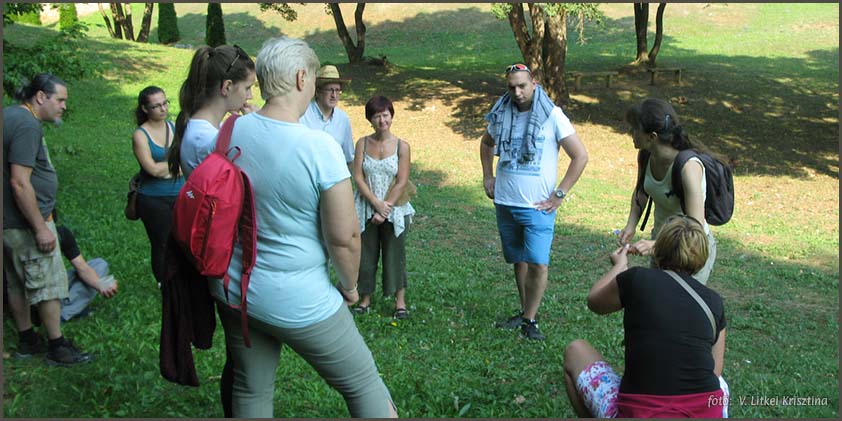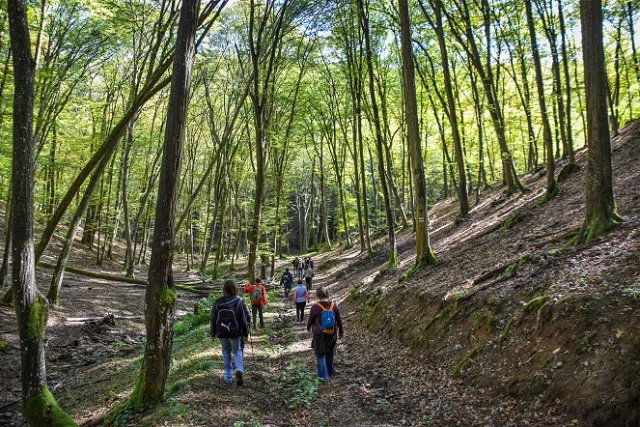
I have always wanted to go on one of these walks and learn about what is growing wild in my own backyard. What is edible? What can be used for healing? Krisztina Visnyovszky led the 2-hour leisurely tour around the Park's Vörös-tó Visitors Centre and Red Lake.
We found the following medicinal herbs (additional source Wikipedia):
- Stinging nettle is used in the treatment of disorders of the kidneys and urinary tract and rheumatism;
- Ribwort plantain (lándzsás utifű) leaves can be used to prepare a tea for cough medicine;
- Coltsfoot (martilapu) can be used internally (as tea or syrup) or externally (directly applied) for treatment of disorders of the respiratory tract, skin, viral infections, flu, colds, fever, rheumatism and gout;
- Dandelion (pongyola pitypang) is used to treat infections and as a diuretic.. In the kitchen, they can be fermented for wine or beer, used in salads or stir-fried, and the ground, roasted roots can be used to make caffeine-free coffee. It is even one of the ingredients of root beer;
- Chicory (mezei katáng), especially the flower, is used as a tonic and as a treatment for gallstones, gastro-enteritis, sinus problems, and cuts and bruises. Chicory contains inulin, which may help humans with constipation;
- Greater celandine/tetterwort/nipplewort/swallowwort (vérehulló fecskefű) is used externally for getting rid of warts. Scour the surface of the wart a bit, and then apply the yellow-orange latex from the plant;
- St John's wort (közönséges orbáncfű) is a well-known herbal treatment for depression. The yellow petals are ringed by tiny black dots, and on closer inspection the green leaves are seen to be perforated;
- Common yarrow (közönséges cickafark) is also known as arrowroot, bad man's plaything, bloodwort, carpenter's weed, death flower, devil's nettle, eerie, field hops, gearwe, hundred leaved grass, knight's milefoil, knyghten, milefolium, nosebleed, old man's mustard, old man's pepper, sanguinary, seven year's love, snake's grass, soldier, soldier's woundwort, stanchweed, thousand seal, woundwort and yarroway. It is used as a diaphoretic, astringent, tonic and stimulant. The plant also has a long history as a powerful 'healing herb' used topically for wounds, cuts and abrasions. Achilles reportedly carried it with his army to treat battle wounds. The leaves encourage clotting, so it can be used fresh for nosebleeds. The aerial parts of the plant are used for phlegm conditions, as a bitter digestive tonic, a diuretic, and to stimulate the circulation. It is also useful in menstrual disorders, and as an effective sweating remedy to bring down fevers. The stalks are dried and used as a randomising agent in I Ching divination. In the Middle Ages, yarrow was part of a herbal mixture known as gruit used in the flavouring of beer prior to the use of hops. The flowers and leaves are used in making some liquors and bitters;
- Hawthorn (egybibés galagonya) berries are edible raw but are commonly made into jams and syrups, and used to make wine. Petals are also edible, as are the leaves, which if picked in spring when still young are tender enough to be used in salads. Tea from the young leaves and flowers in spring are very good to strengthen the heart;
- Sloe (kökény) stones can be sucked on to reduce thirst, and the berries after the first frost can be used to make sloe gin/vodka;
- Wild thyme (mezei kakukkfű) is an active ingredient in mouthwash. Before the advent of modern antibiotics, oil of thyme was used to medicate bandages. Thyme has also been shown to be effective against various fungi that commonly infect toenails. As tea it can be used for coughs and bronchitis;
- Common agrimony/church steeples/sticklewort (apróbojtorján/közönséges párlófű);
- Greater burdock or beggar's buttons (nagy bojtorján/bogáncs) was used during the Middle Ages as a vegetable, but now it is rarely used, with the exception of Japan, Taiwan and Korea. Immature flower stalks may also be harvested in late spring before flowers appear. The taste resembles that of artichoke, to which the burdock is related. It is used as a diuretic, diaphoretic, and a blood purifying agent.
Daniel Swartz



